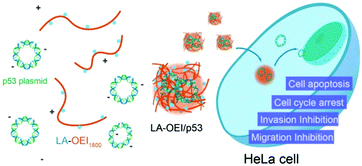Inhibition of proliferation and migration of tumor cells through lipoic acid-modified oligoethylenimine-mediated p53 gene delivery†
Abstract
The modification of oligoethylenimine with lipoic acid was conducted to synthesize a biocompatible gene carrier LA-OEI, which was demonstrated to possess favorable transfection efficacy through the delivery of pEGFP-N3 and pGL-3 plasmids. The anti-tumor effects of LA-OEI/p53 transfection were then systematically evaluated using the HeLa cell line (p53 wild type) as a model. The up-regulation of p53 expression could be detected at the mRNA and protein levels using quantitative real-time PCR and western blotting, respectively. The anti-proliferative effects were analyzed using the MTT method, Live/Dead staining and colony formation inhibition, indicating that LA-OEI/p53 transfection could achieve stronger inhibition of cell proliferation than OEI/p53. The mechanism was identified to be associated with the induction of cell apoptosis and cell cycle arrest at S phase, and the former was caused by the activation of a mitochondria-dependent apoptosis pathway based on western blotting analysis, caspase-3, -8, and -9 activity and mitochondrial membrane potential detection. Finally, LA-OEI-mediated p53 transfection could trigger the inhibition of cell migration, revealed by wound healing and Transwell migration assays. Overall, this OEI derivative-mediated delivery of this therapeutic gene has shown its potential in tumor gene therapy, which is anticipated to be a promising technique in future clinical applications.



 Please wait while we load your content...
Please wait while we load your content...